 “Artists, across eras and geographies have intuitively or consciously given form to material inter-relationships in a unique way. The artwork is never a given and never an end point, but an emergence, a moment of becoming, a contingent confluence of the multiple histories of matter.”
“Artists, across eras and geographies have intuitively or consciously given form to material inter-relationships in a unique way. The artwork is never a given and never an end point, but an emergence, a moment of becoming, a contingent confluence of the multiple histories of matter.”
– Greg Hilty, Lisson Gallery Partner and curator of ‘Matter as Actor’
This group exhibition brings together works by artists who present mutable forms of matter – whether embodied in clay, rock, pigment, plastic, metal or organic substances – as active agents in the complex entanglements of humans and the more-than-human world. Moving beyond the idea of nature as raw material abundantly available for humans to use, this exhibition acknowledges the distinct properties, agencies and histories of materials, taking heed of their dynamic role in sustaining dense, interwoven relations. These artists come from many parts of the world and critically engage with the materials associated with their respective cultural inheritances. Their work speaks to the challenges as well as the insights of engaging with the material world across, as well as within, distinct cultural frameworks. In giving shape to the conceptual insights of multiple situated knowledge systems, the artists and artworks in the exhibition, spanning both London galleries but each given their individual space, attest to the pluralistic grounds of contemporary existence.
 Zhan Wang, Match Openings: Particle (對(duì)陣:粒子) series and Match Openings: Scrawls of Visions (對(duì)陣:萬象涂) series, 2022. Installation view of 'Matter as Actor' at Lisson Gallery, London, 3 May – 24 June 2023. Courtesy Lisson Gallery
Zhan Wang, Match Openings: Particle (對(duì)陣:粒子) series and Match Openings: Scrawls of Visions (對(duì)陣:萬象涂) series, 2022. Installation view of 'Matter as Actor' at Lisson Gallery, London, 3 May – 24 June 2023. Courtesy Lisson Gallery
Zhan Wang’s presentation, collectively titled Match Openings, following the first positions in a chess game, includes his latest body of sculptural works and ink paintings. The sculptures are an evolution of his stainless-steel artificial replicas of the ‘scholar’s rocks’ traditionally found in Chinese gardens. Zhan applies the philosophical concept of the Dichotomy Paradox to the segmentation of each stone, before reconstructing the fragments to make an ever-expanding set of new modules. The mirrored surfaces of these previously organic objects are arranged on a tessellating grid of nine plinths that rotate and morph on a weekly basis, in formations that represent light, air, earth/ocean/plant, star, fish/insect, human/animal, and finally, rest. This conceptual and lyrical bed of stones stimulates philosophical slippage between the natural and manmade worlds, between the technological and the archaeological, but also between energies, elements and materials.
The ink paintings on rice paper shown alongside the sculptures are placed within two five-by-five matrices. Operating under a strict rule that the brushstrokes not overlap or touch each other, the artist seeks to paint with near-absolute spontaneity, resulting in abstraction and a similar, shifting mode of conceptual, time-based display that, in his own words, is “both accidental and inevitable”.
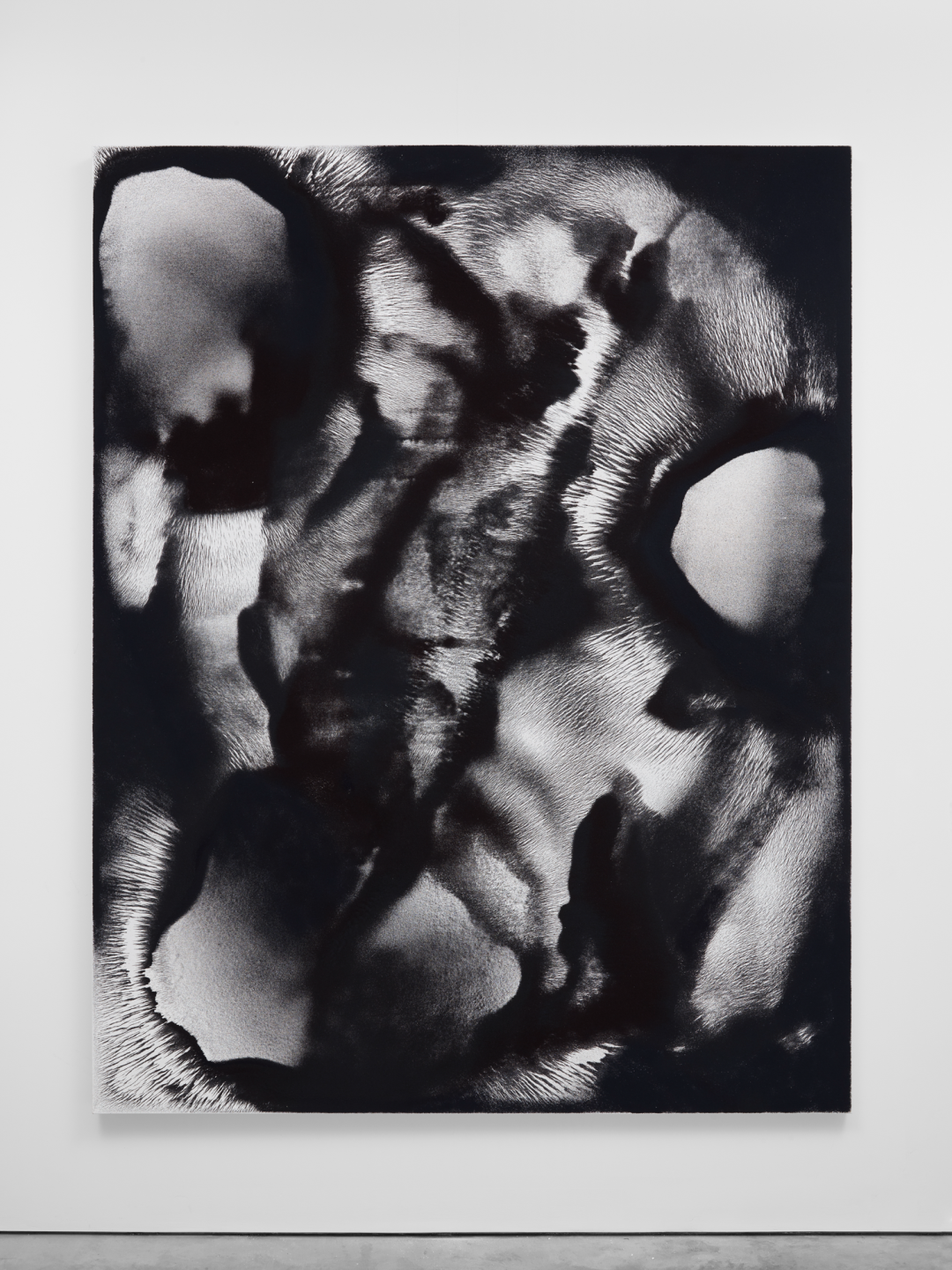 Allora & Calzadilla, Electromagnetic Field (July 27, 2020, Meter Number 96215234, Fuel Charge Adj 2,800kWh x $0.05534, Purchase Power Charge Adj 2,800kWh x $0.046489, Municipalities Adj 2,800kWh x $0.004094, Subsidies, Public Light & other Subv HH, 2,800kWh x $0.008991, Subsi, 2020, Magnetite on linen, 243.8 x 182.9 x 4.4 cm ? Allora & Calzadilla. Courtesy Lisson Gallery
Allora & Calzadilla, Electromagnetic Field (July 27, 2020, Meter Number 96215234, Fuel Charge Adj 2,800kWh x $0.05534, Purchase Power Charge Adj 2,800kWh x $0.046489, Municipalities Adj 2,800kWh x $0.004094, Subsidies, Public Light & other Subv HH, 2,800kWh x $0.008991, Subsi, 2020, Magnetite on linen, 243.8 x 182.9 x 4.4 cm ? Allora & Calzadilla. Courtesy Lisson Gallery
Allora & Calzadilla’s Electromagnetic Field series, initiated in 2018, take electromagnetism, one of the four fundamental forces of nature, as its subject and medium. The artists experiment with electromagnetism to create forms that are at once abstract and referential. They drop iron filings on top of a canvas and place it above an array of copper cables connected to an electrical breaker in their studio in San Juan, Puerto Rico. When the breaker is turned on, the electrical current forces the particles into an arrangement of shapes and patterns governed by the electromagnetic field. Attraction and repulsion, strength and weakness, accumulation and dispersal are some of the tools the artists employ to find formal resolution in the electromagnetic works. However, the rhythmic balance achieved does not mute the pulsing forces that condition the very appearance of the artwork – from stock market cycles to fossil fuel combustions. The parenthetical component of the work’s title, a lengthy sequence of numbers and letters that they took from their studio electric bill, refers to the politics related to the generation, ownership, and distribution of electricity.
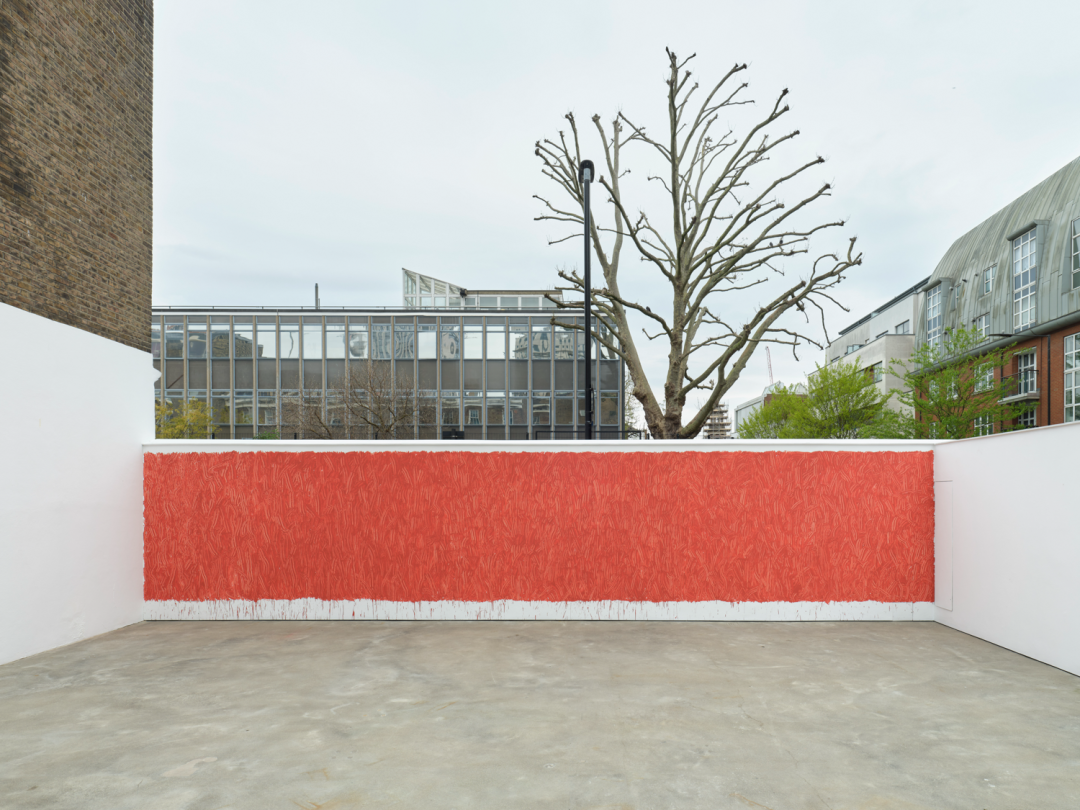 Richard Long, Red River, 2023, Paint, Dimensions variable. Installation view of 'Matter as Actor' at Lisson Gallery, London, 3 May – 24 June 2023 ? Richard Long. Courtesy Lisson Gallery
Richard Long, Red River, 2023, Paint, Dimensions variable. Installation view of 'Matter as Actor' at Lisson Gallery, London, 3 May – 24 June 2023 ? Richard Long. Courtesy Lisson Gallery
Richard Long’s site-specific wall work continues a series of temporary murals in paint, clay and mud that date back to other previous large-scale examples, such as Red Earth Circle, made for the ‘Magiciens de la Terre’ exhibition at the Centre Pompidou in 1989. Long manipulates the viscosity of this earthy, primal and colourful material against a backdrop or surface. Leaving behind gestural indexes of his explorative strokes, Long explores the interaction of multiple, conflicting natural and man-made forces.
He has made numerous other works referencing the colour red, including Red Walk (1986), which features a body of typographic text that documents a walk Long took from his home to Cornwall, picking out punctuations of red from a ‘Gypsies’ Fire’ to a ‘Cock Pheasant’s Face’. Another work from the same year, Red Slate Line, which was on long-term view at Yorkshire Sculpture Park, as well as the Guggenheim Museum’s earlier piece, Red Slate Circle (1980), were both made from a deep-red slate found at the border of Vermont and New York State. Long often employs mud from the River Avon, sourced from what he calls his ‘home’ river, which runs through Bristol, although he has, on occasion, also employed terracotta slip or a rich red clay from the region of Vallauris, the French capital of pottery and ceramic arts. He refers to the tactility and material simplicity of tidal and river mud, as well as its geological significance, having been created by the movement of water over millions of years. He sees it as: “a mixture of time, water and stone”.
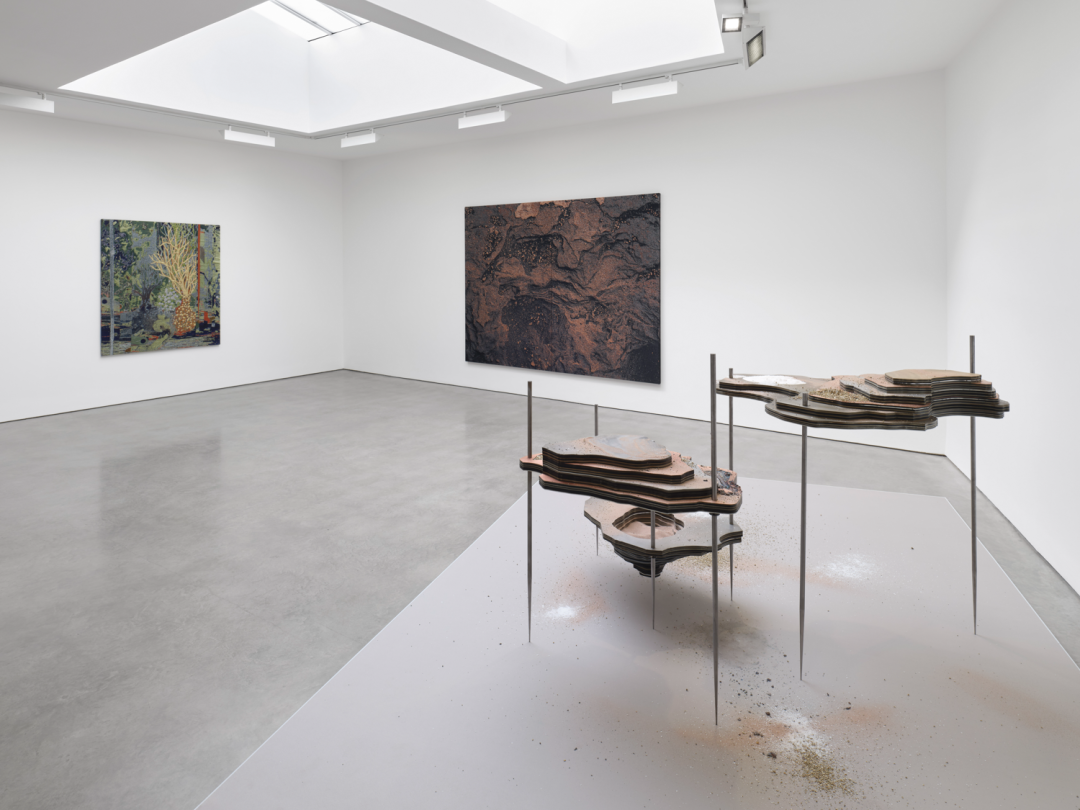 Installation view of Otobong Nkanga at 'Matter as Actor', Lisson Gallery, London, 3 May – 24 June 2023. Courtesy Lisson Gallery
Installation view of Otobong Nkanga at 'Matter as Actor', Lisson Gallery, London, 3 May – 24 June 2023. Courtesy Lisson Gallery
Otobong Nkanga’s presentation centres around the installation Solid Maneuvers (2015), a manifestation of her encounters with an area devastated by mining in Namibia known as ‘Green Hill’, which, since 1875, has seen its mineral-rich soil hollowed out, leaving a scar in the landscape. Solid Maneuvers, a poeticized translation of Green Hill’s inverted, excavated topography – containing vermiculite, salt, make up, heavy mineral sands and shredded copper – serves as a poignant reminder of the ecological implications of capitalist accumulation. Integrating performance into the work, Nkanga considers how the machinery used for mining these landscapes are informed by the physical gestures of the human body.
The two vertical, sculptural Posts (2019) continue this exploration through photographic documentation of different regions of the world that Nkanga has encountered, allowing visitors to scroll through the carousels of graduating colour, beginning with the green flora and fauna before taking in the greys and browns of decay and abandon (returning, eventually, once again to green). Two hanging works, Steel to Rust – Meltdown (2016) and The Rift (2023) allude to social, economic and industrial corrosion and its physical and emotional repurcussions for the human body and the environment.
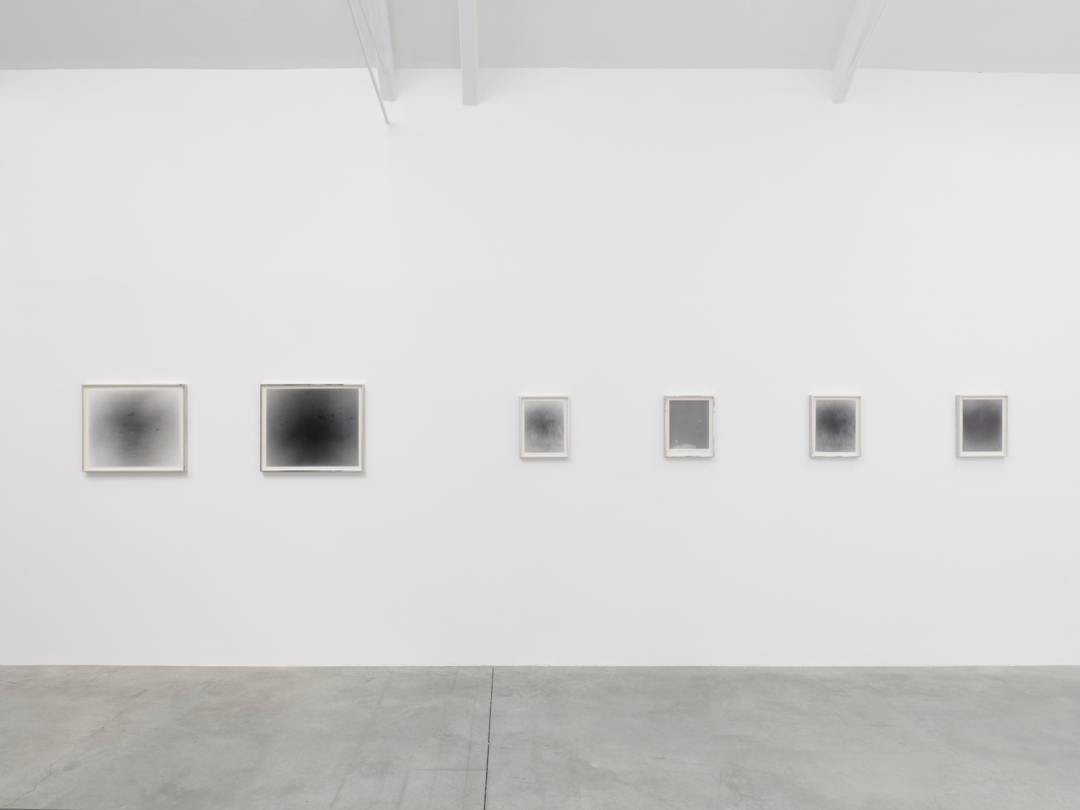 Lucy Raven, Untitled series, 2021-2022. Installation view of 'Matter as Actor' at Lisson Gallery, London, 3 May – 24 June 2023. Courtesy Lisson GalleryThis selection of works from a series of more than 60 unique silver gelatin shadowgrams, entitled Socorro! (2021–22) by American artist Lucy Raven, record the elemental pressures of air and raw materials from a number of explosive events by exposing photosensitive paper for micro-seconds after detonation. Her empirical experiments, using a stroboscopic flash within a custom-built, room-sized black box at a Ballistics Sciences Lab, resulted in these subtly inflected abstractions, rendered as silhouettes with occasional impact marks created by flying debris. Raven’s images are witness to the unseen forces of blast waves as they radiate away from the source towards the surface of each unique shadowgram, transforming material forces into abstract marks and physical remnants in the wake of these extreme events.
Lucy Raven, Untitled series, 2021-2022. Installation view of 'Matter as Actor' at Lisson Gallery, London, 3 May – 24 June 2023. Courtesy Lisson GalleryThis selection of works from a series of more than 60 unique silver gelatin shadowgrams, entitled Socorro! (2021–22) by American artist Lucy Raven, record the elemental pressures of air and raw materials from a number of explosive events by exposing photosensitive paper for micro-seconds after detonation. Her empirical experiments, using a stroboscopic flash within a custom-built, room-sized black box at a Ballistics Sciences Lab, resulted in these subtly inflected abstractions, rendered as silhouettes with occasional impact marks created by flying debris. Raven’s images are witness to the unseen forces of blast waves as they radiate away from the source towards the surface of each unique shadowgram, transforming material forces into abstract marks and physical remnants in the wake of these extreme events.
 Dana Awartani, Let me mend your broken bones 3, 2023, Darning on medicinally dyed silk and paper, 8 parts, each: 27 x 36 cm, 10 5/8 x 14 1/8 in ? Dana Awartani. Courtesy Lisson GalleryIn her latest work, Dana Awartani meditates on themes of sustainability and cultural destruction. The work is composed of naturally dyed silk fabrics, handmade in Kerala, which have been stretched onto frames and displayed in a serial manner along the gallery’s walls. The fabrics are saturated with a multitude of natural herbs and spices that have specific medicinal functions in South Asian and Arab cultures. Awartani’s material choices speak to the work’s ethical and ecological terms of production, and further embody acts of resistance against mental and technological colonial violence given the dual emphasis on artisanal production and indigenous medicinal knowledges. Awartani also creates tears and holes in the textiles, which correspond to the silhouettes of physical violence enacted on buildings in Arab nations at the hands of Islamic fundamentalists. Sourced from the Antiquities Coalition (an organisation that catalogues and protects these vulnerable heritage sites), the accompanying texts for each panel list the exact location and time of these traumatic events, as well as the cause and the group claiming responsibility. Mending these punctures through a process of darning (tracing holes or rubble with thread), Awartani’s work metaphorises possibilities of collective healing while recalling a venerable tradition of repairing and revering objects.
Dana Awartani, Let me mend your broken bones 3, 2023, Darning on medicinally dyed silk and paper, 8 parts, each: 27 x 36 cm, 10 5/8 x 14 1/8 in ? Dana Awartani. Courtesy Lisson GalleryIn her latest work, Dana Awartani meditates on themes of sustainability and cultural destruction. The work is composed of naturally dyed silk fabrics, handmade in Kerala, which have been stretched onto frames and displayed in a serial manner along the gallery’s walls. The fabrics are saturated with a multitude of natural herbs and spices that have specific medicinal functions in South Asian and Arab cultures. Awartani’s material choices speak to the work’s ethical and ecological terms of production, and further embody acts of resistance against mental and technological colonial violence given the dual emphasis on artisanal production and indigenous medicinal knowledges. Awartani also creates tears and holes in the textiles, which correspond to the silhouettes of physical violence enacted on buildings in Arab nations at the hands of Islamic fundamentalists. Sourced from the Antiquities Coalition (an organisation that catalogues and protects these vulnerable heritage sites), the accompanying texts for each panel list the exact location and time of these traumatic events, as well as the cause and the group claiming responsibility. Mending these punctures through a process of darning (tracing holes or rubble with thread), Awartani’s work metaphorises possibilities of collective healing while recalling a venerable tradition of repairing and revering objects.
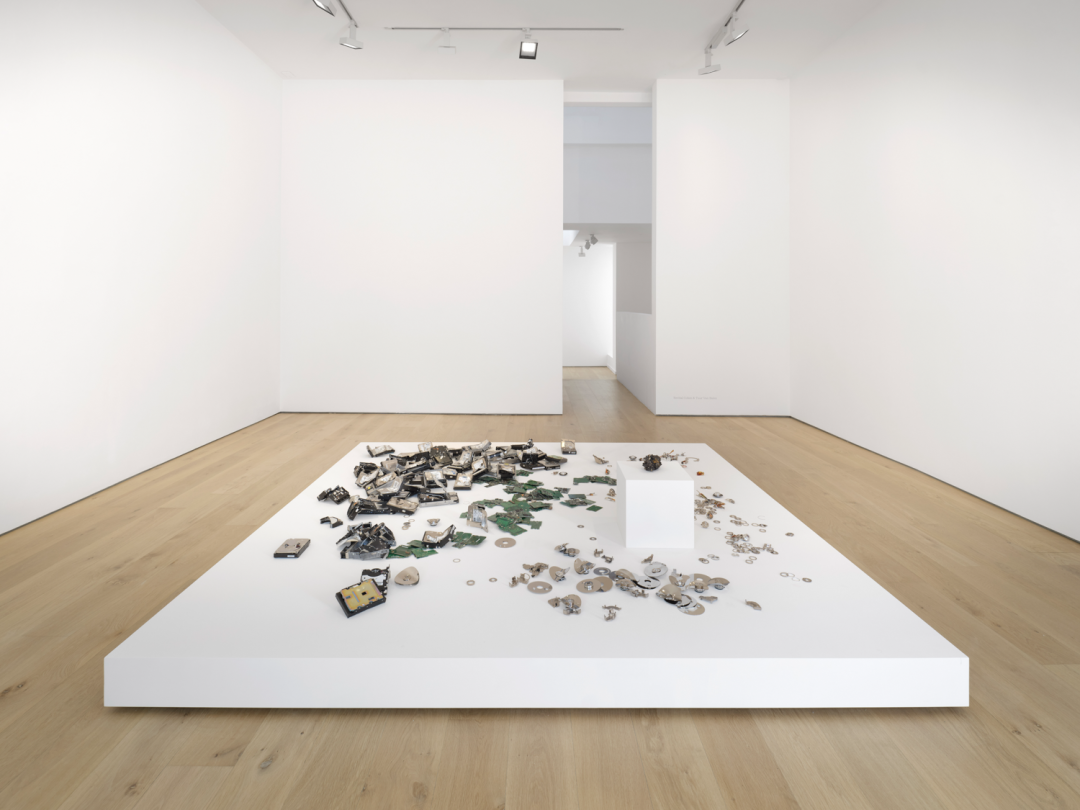 Revital Cohen & Tuur Van Balen, B/NdAlTaAu, 2015, Neodymium, Aluminium, Gold, Tantalum, Dimensions Variable. Installation view of 'Matter as Actor' at Lisson Gallery, London, 3 May – 24 June 2023 ? Revital Cohen & Tuur Van Balen. Courtesy Lisson Gallery
Revital Cohen & Tuur Van Balen, B/NdAlTaAu, 2015, Neodymium, Aluminium, Gold, Tantalum, Dimensions Variable. Installation view of 'Matter as Actor' at Lisson Gallery, London, 3 May – 24 June 2023 ? Revital Cohen & Tuur Van Balen. Courtesy Lisson Gallery
Revital Cohen and Tuur Van Balen explore processes of production as cultural, personal and political practices. In their installation, B/NdAlTaAu, (2015) Cohen and Van Balen reverse the manufacture of hard drives, mining these devices for their natural, precious metals (as listed in the title: neodymium, aluminium, gold and tantalum), in order to create a new, manmade mineral.
Forty kilogrammes of destroyed hard drives were sourced from a data destruction service, a mountain of shiny deformed bricks that were scrapped out of the guts of computers. Mined out of soil, designed in the United States, made in China, destroyed in England. Labour starts in reverse, dissolving the virtual into the fake from the other end of the consumption chain... Neodymium (Nd) magnets are shredded with a water jet, tantalum (Ta) is filed out of capacitors and the gold (Au) recovered with acids. The aluminium (Al) platters – still holding their ones and zeros – are melted and recast in a sand mould. An artificial ore emerges from the earth, unexpectedly black.
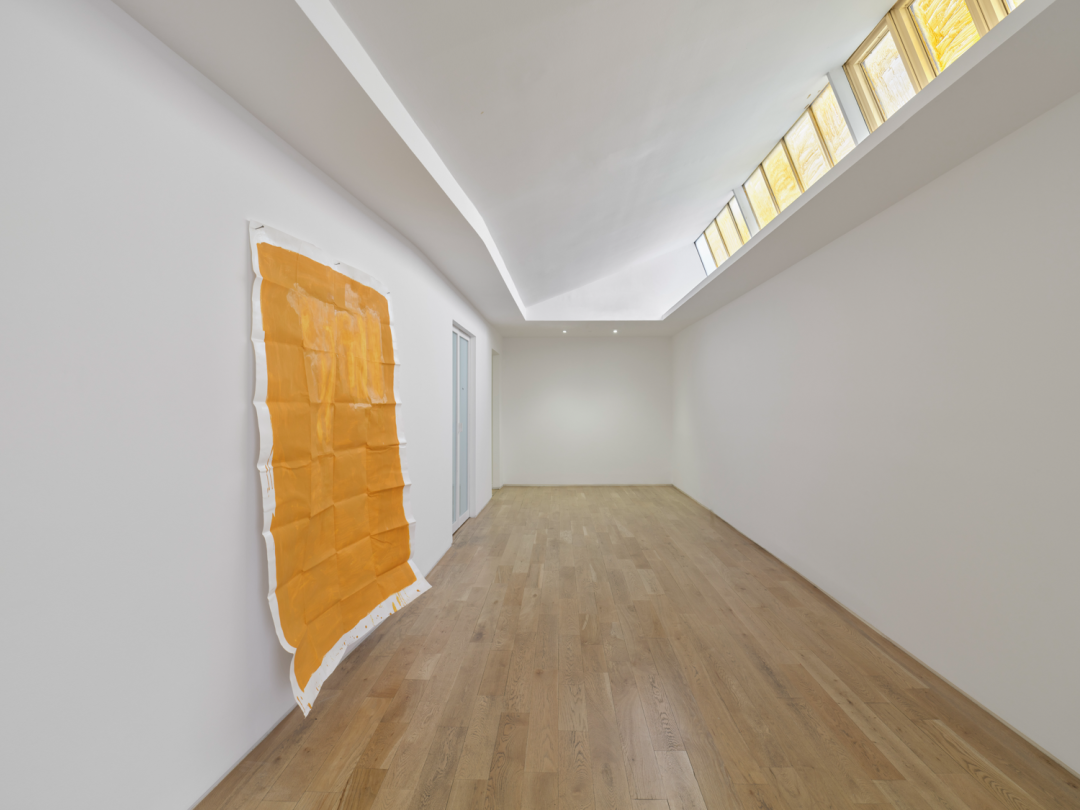 D Harding, As I remember it, 2022, Powdered pigment, gum acacia on 200gsm Fabriano Accademia paper with pigment and gum acacia transfer. 205 x 150 cm ? D Harding. Installation view of 'Matter as Actor' at Lisson Gallery, London, 3 May – 24 June 2023. Courtesy Lisson Gallery
D Harding, As I remember it, 2022, Powdered pigment, gum acacia on 200gsm Fabriano Accademia paper with pigment and gum acacia transfer. 205 x 150 cm ? D Harding. Installation view of 'Matter as Actor' at Lisson Gallery, London, 3 May – 24 June 2023. Courtesy Lisson Gallery
Occupying the gallery’s top floor, D Harding’s pigment paintings and site-specific interventions include white ochre pigment transported from Aboriginal lands in Central Queensland and store-bought yellow pigments. The artist uses these to frost the gallery windows up to head height, and flood the skylights with a yellowish hue, implying the artist’s embodiment of the reality of materials brought from thousands of miles away, representing not only culture and heritage, but also place, landscape and memory.
Two further paintings on stretched linen, again featuring Harding’s collected pigments and materials, incorporate not only a surface of crushed antiretroviral PrEP drugs and lapis lazuli oil paint, but also a deep red colour, made from earth gathered, on one side of a diptych, from the artist’s grandmother’s country (Ghungalu) and, on the pendant piece, from their grandfather’s country (Bidjara). These works suffuse the spaces with a distillation of the knowledge and experience gathered across millennia by Harding’s ancestors, both ancient and recent, both pre-colonial and colonial. Harding’s considered and gestural acts both channel and render physical the autonomy of sites and substances of great importance to First Nations Australians and, by association, to the places and ecologies that have nourished human wellbeing. Harding’s grandfather identified the relation between people in place as yoonthalla.
 Irmel Kamp, Zink series, 1978-1982, Gelatin silver print. Framed: 50.5 x 40.5 x 2.3 cm / 19 7/8 x 16 x 0 7/8 in (each) ? Irmel Kamp. Courtesy Lisson GalleryIrmel Kamp’s first large grouping of works, Zink (1978–82) began as a means of documenting a local building phenomenon in villages between Aachen and Liège and how the zinc cladding, mined at Kelmis on the German-Belgian border, shaped the landscape of the local area. The use of sheet zinc harks back to a 19th-century practice, when it was used primarily as a uniform roofing material for Baron Haussmann’s urban planning measures in Paris. In these images it has been used in various arrangements to protect the facades or sides of existing residential and commercial buildings in East Belgium – constituting a modern, material addition to existing architecture. Her serial and objective approach allows for cultural-historical, as well as sociological-atmospheric readings of the importance of zinc, an element also present in the human body.
Irmel Kamp, Zink series, 1978-1982, Gelatin silver print. Framed: 50.5 x 40.5 x 2.3 cm / 19 7/8 x 16 x 0 7/8 in (each) ? Irmel Kamp. Courtesy Lisson GalleryIrmel Kamp’s first large grouping of works, Zink (1978–82) began as a means of documenting a local building phenomenon in villages between Aachen and Liège and how the zinc cladding, mined at Kelmis on the German-Belgian border, shaped the landscape of the local area. The use of sheet zinc harks back to a 19th-century practice, when it was used primarily as a uniform roofing material for Baron Haussmann’s urban planning measures in Paris. In these images it has been used in various arrangements to protect the facades or sides of existing residential and commercial buildings in East Belgium – constituting a modern, material addition to existing architecture. Her serial and objective approach allows for cultural-historical, as well as sociological-atmospheric readings of the importance of zinc, an element also present in the human body.
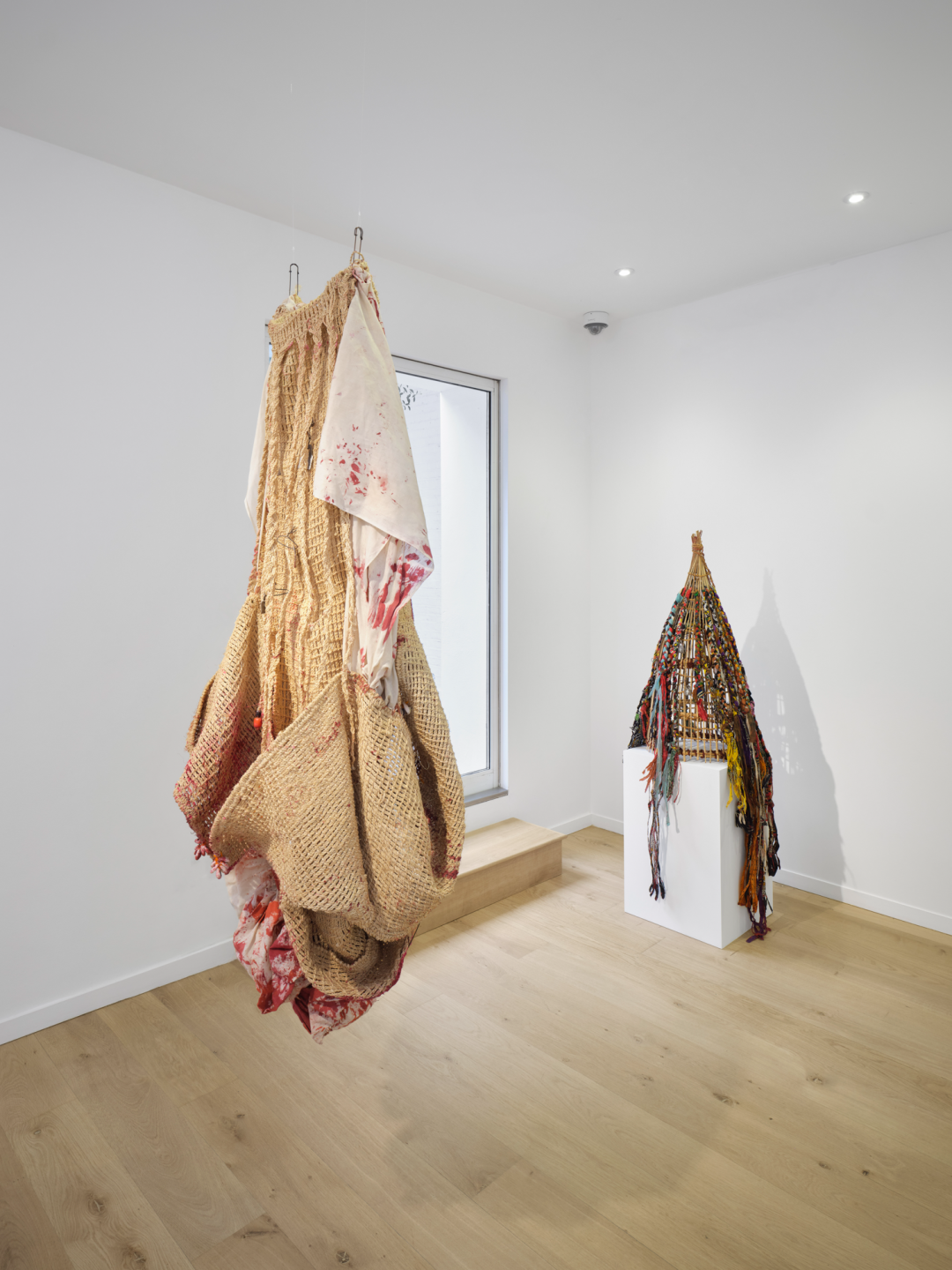 Syowia Kyambi, Entity Costume part of Fracture (i), 2011, Sisal costume and woven reed headdress. Costume Dims: 158 x 95 x 70 cm ? Syowia Kyambi. Installation view of 'Matter as Actor' at Lisson Gallery, London, 3 May – 24 June 2023. Courtesy Lisson GalleryThese works by Syowia Kyambi document a body of installation and performance work, known as Fracture (i) (2011–16). These performances think through the contemporary afterlives of British colonialism in Kenya and speculate on possibilities for personal and collective, as well as mental and structural, transformation. Kyambi wears this costume made from sisal, which she constructed using the Kamba weaving method, conventionally employed for making kiondos (local handwoven bags). In doing so, the outfit juxtaposes the discredited transgenerational knowledges sedimented in these Kenyan handicraft traditions with the historical materiality of colonial sisal plantations.
Syowia Kyambi, Entity Costume part of Fracture (i), 2011, Sisal costume and woven reed headdress. Costume Dims: 158 x 95 x 70 cm ? Syowia Kyambi. Installation view of 'Matter as Actor' at Lisson Gallery, London, 3 May – 24 June 2023. Courtesy Lisson GalleryThese works by Syowia Kyambi document a body of installation and performance work, known as Fracture (i) (2011–16). These performances think through the contemporary afterlives of British colonialism in Kenya and speculate on possibilities for personal and collective, as well as mental and structural, transformation. Kyambi wears this costume made from sisal, which she constructed using the Kamba weaving method, conventionally employed for making kiondos (local handwoven bags). In doing so, the outfit juxtaposes the discredited transgenerational knowledges sedimented in these Kenyan handicraft traditions with the historical materiality of colonial sisal plantations.
 Installation view of Yelena Popova at 'Matter as Actor', Lisson Gallery, London, 3 May – 24 June 2023 ? Courtesy Lisson GalleryPromethean Chalice (2020) combines ancient geometry, astronomy, solar power, mathematics and atomic fusion, proffering sustainable, ecological solutions for utilising nuclear energy. At the centre of the chalice is a torus, a continuous bagel-shaped vortex mirroring the human aura, in which energy flows through the head and loops down to the feet and back up through the body. Influenced by Popova’s mother’s architectural drawings and her father’s knowledge of electricity and chemical reactions, Ripple-Marked Radiance: after Hertha Ayrton (2019) also pays homage to a pioneering British scientist and suffragette, Hertha Ayrton (1854-1923), who became the first female member of the Institution of Electrical Engineers after her late nineteenth-century research into arc lighting.
Installation view of Yelena Popova at 'Matter as Actor', Lisson Gallery, London, 3 May – 24 June 2023 ? Courtesy Lisson GalleryPromethean Chalice (2020) combines ancient geometry, astronomy, solar power, mathematics and atomic fusion, proffering sustainable, ecological solutions for utilising nuclear energy. At the centre of the chalice is a torus, a continuous bagel-shaped vortex mirroring the human aura, in which energy flows through the head and loops down to the feet and back up through the body. Influenced by Popova’s mother’s architectural drawings and her father’s knowledge of electricity and chemical reactions, Ripple-Marked Radiance: after Hertha Ayrton (2019) also pays homage to a pioneering British scientist and suffragette, Hertha Ayrton (1854-1923), who became the first female member of the Institution of Electrical Engineers after her late nineteenth-century research into arc lighting.
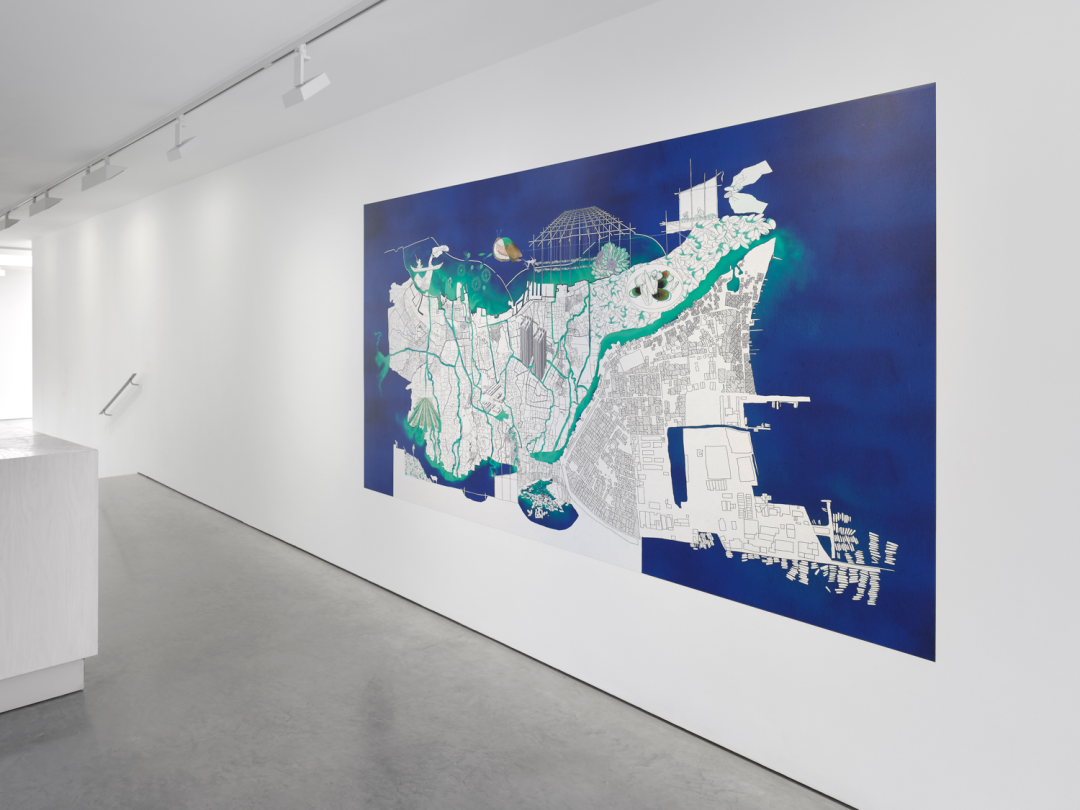 Zhou Feifei, Flowing Toxins, 2020, Digitally printed wallpaper, 168 x 300.6 cm, 66 1/8 x 118 3/8 in ? Feifei Zhou. Installation view of 'Matter as Actor' at Lisson Gallery, London, 3 May – 24 June 2023. Courtesy Lisson GalleryFlowing Toxins elucidates how infrastructures arrange water supply, sewage, and property into shifting relationships that variably reproduce structures of urban inequality in Jakarta, Indonesia. Across various scales, perspectives, and dimensionalities, the drawing displays multiple narratives and material processes at once. There are many entry points to reading the drawing, showing the simultaneity and multiplicity of the ecologies through which the material landscape and structural inequality co-shape one another.
Zhou Feifei, Flowing Toxins, 2020, Digitally printed wallpaper, 168 x 300.6 cm, 66 1/8 x 118 3/8 in ? Feifei Zhou. Installation view of 'Matter as Actor' at Lisson Gallery, London, 3 May – 24 June 2023. Courtesy Lisson GalleryFlowing Toxins elucidates how infrastructures arrange water supply, sewage, and property into shifting relationships that variably reproduce structures of urban inequality in Jakarta, Indonesia. Across various scales, perspectives, and dimensionalities, the drawing displays multiple narratives and material processes at once. There are many entry points to reading the drawing, showing the simultaneity and multiplicity of the ecologies through which the material landscape and structural inequality co-shape one another.
About the Exhibition
Dates: 3 May – 24 June 2023
Venue: Lisson Gallery, London




























